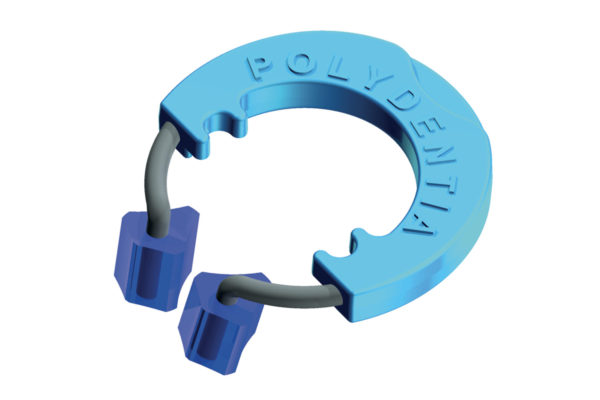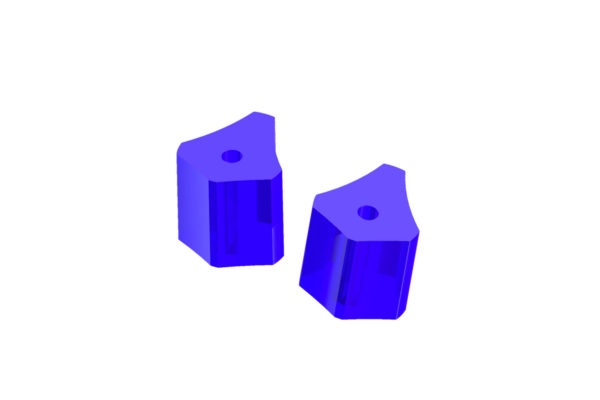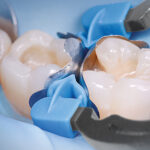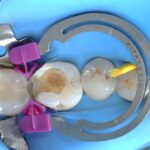13 Dec Dr. Giuseppe Chiodera – Replacement of old Amalgams – myRing Classico and Diamond24
Replacement of old Amalgams with myRing Classico and Diamond24
by Dr. Giuseppe Chiodera

Dr. Giuseppe Chiodera
Dr. Chiodera graduated in Dentistry at the University of Brescia .
In year 2004 he won a scholarship at Kings College University of London.
Honorary member of Style Italiano, Dr. Chiodera is dedicated to his private practice in Italy since 2006 and his practice is mainly dedicated to conservative dentistry and endodontics .
Dr. Chiodera is also very active as author of National and International Journal articles, as well as Lecturer in many Universities.
clinical case
The patient came to our attention for a regular check. A first analysis revealed multiple carious lesion under a previous amalgam on both molars 26 and 27 and second bicuspid 25. We decided to proceed to the elimination of the old amalgams and carious lesion followed by a direct composite restoration of the cavities.
The following case shows the step-by-step restoration procedure using Polydentia myRing Classico separator ring equipped with the new Diamond24 silicone tubes.

1: Pre-operative view of 26 and 27 molars and 25 bicuspid showing the old amalgam restorations which need replacement.
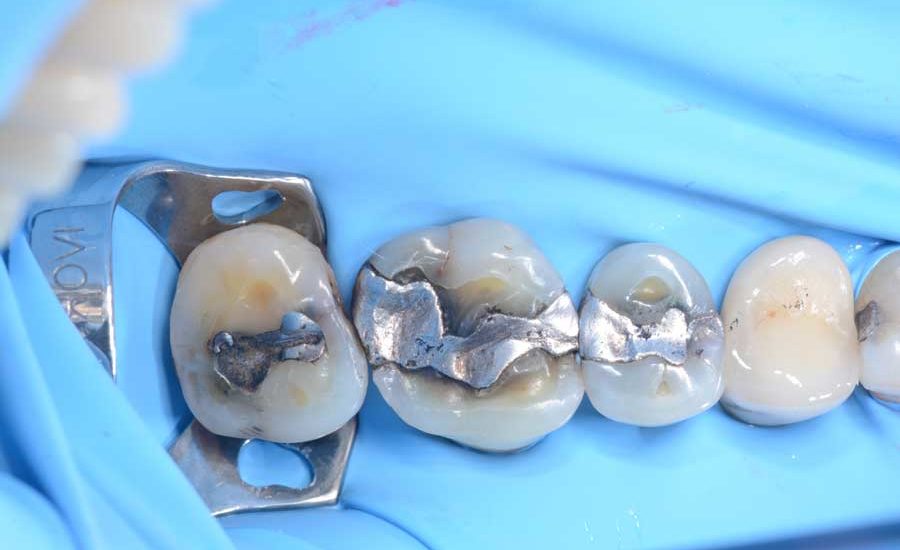
2: The quadrant under isolation before removing the old restorations.

3: Wedging and cavity preparation: a standard wooden wedge was used to separate bicuspid 25 and molar 26, while a Macro Wedge by Polydentia was used to separate the molars. Macro Wedge wedges are very effective in case of wide cervical spaces, where the size of standard wedges is not enough to ensure a correct teeth separation. The old amalgams have been then removed.
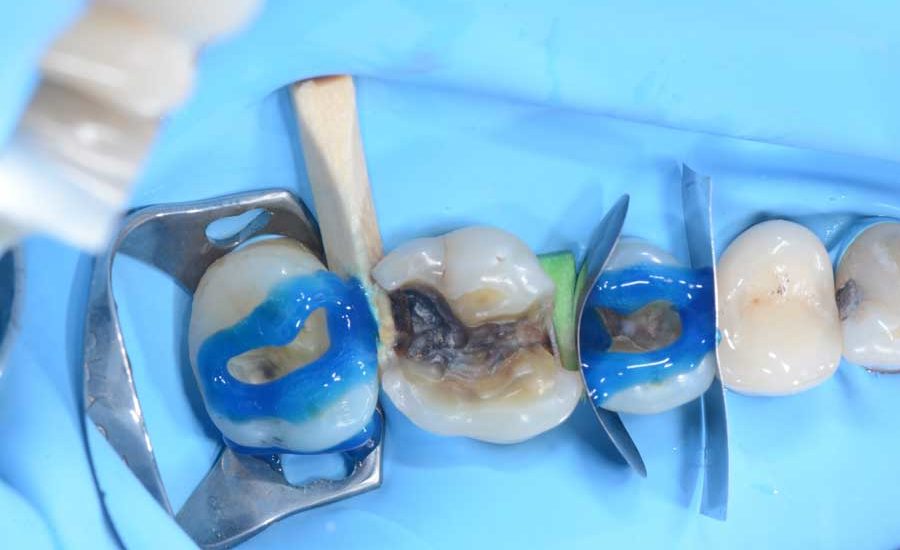
4: Bicuspid and second molar were restored first. As a first step, a LumiContrast matrix (Polydentia) was placed prior to etching procedure. A steel matrix strip was also used to protect the first bicuspid. Cavities on both #25 and #27 were filled with composite, cured and then finished.
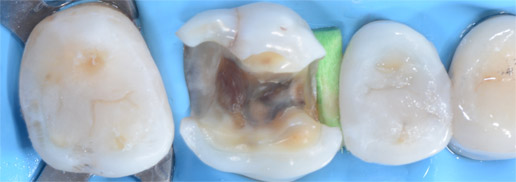
5: The clinical situation after restoration of premolar 25 and molar 27. After that we focused on the MOD restoration of molar 26. As first the cavity was cleaned using air abrasion and disinfected. The wooden wedge was broken in order to better accommodate myRing Classico with Diamond24 (Polydentia). This trick is very helpful in case of small teeth.
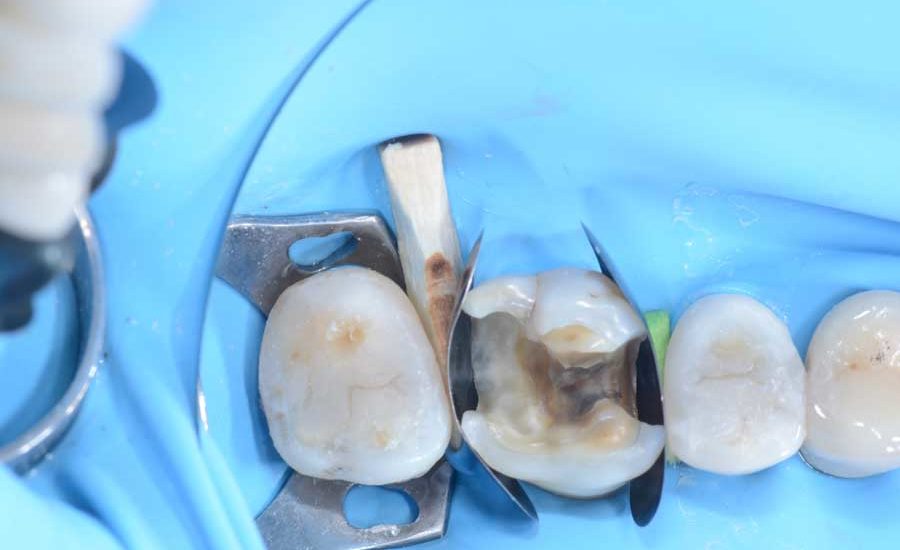
6: Two LumiContrast matrices were placed on first molar. The Macro Wedge was shaped for better positioning and avoid the matrix to collapse on the cervical area.
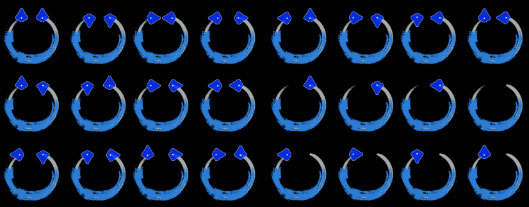
7: The different 24 combinations offered by Diamond24 and myRing Classico on a single image; the new silicon tines can be oriented and combined ensuring an optimal adaption of the matrix to the tooth surfaces.
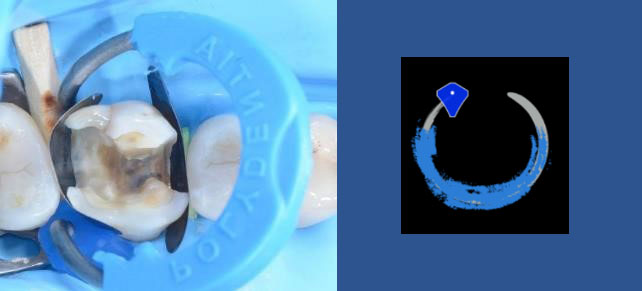
8: The cavity equipped with myRing Classico and Diamond24 on distal. By orienting and combining the silicon tines, the ring can be “semi customized” ensuring an optimal adaption of the matrix to the tooth surfaces.
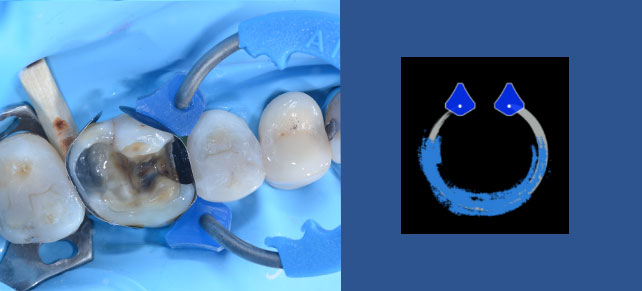
9: After restoration of the distal interproximal wall, myRing Classico was moved to the mesial wall. In this case two Diamond24 were used; different edges length has been especially developed to ensure the best adaption to the matrix even in case of teeth with different dimensions. This feature ensures a faithful contact point restoration.

10: #26 after restoration of the distal interproximal wall; myRing Classico was removed and LumiContrast sectional matrices detached. The picture highlights the optimal adaption of the Diamond24 to the proximal walls, which ensure a perfect contact point restoration with just minor finishing required.

11:The restoration after filling of the occlusal cavity and composite modeling.
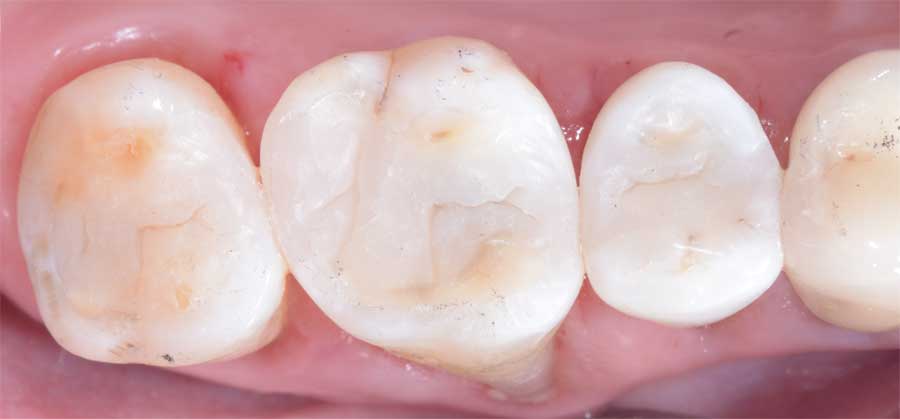
12: Immediate post-operatory result
conclusion
An accurate reproduction of the contact point and proximal walls is a must in class II restorations. Many different sectional matrix rings have been developed to help dentists to achieve perfect restorations. Combining myRing Classico with the new Diamond24 offers additional flexibility in adapting the sectional matrix system to the clinical situation. Particularly, the 24 possible combinations of size and shape of Diamond24 allow to “semi customize” the ring and adapt the matrix in a very efficient way without damaging and collapsing it on the cavity, even in case of difficult tooth morphologies.
other clinical cases
-
Class II adjacent cavities on 1st and 2nd molars – QuickmatFIT anatomical sectional matrices & myRing Forte – Dr David Gerdolle
A 28-year-old female patient, without any systemic medical conditions presented with a carious lesion affecting both molar 46D and 47M. The following case illustrates the direct composite restoration of the lesion using the Polydentia QuickmatFIT anatomical sectional matrices in combination with myRing Forte and myWedge plastic v-shaped wedges....
-
Class II cavity direct composite restoration on a young permanent premolar – myClip 2.0 – Dr Marina Papachroni
For young patients rebuilding the anatomy in class II cavity restorations is a major issue but not making too many occlusal adjustments after finishing the layering procedures is one of the same importance aspects. The following images show the step-by-step treatment we performed for treating decay on the upper first premolar of a 15-year-old teenager. ...
-
Class II cavity direct restoration on young permanent molar with myQuickmat Forte – Dr Marina Papachroni
Class II (interproximal) decay involves the proximal surface of a posterior tooth and it is a common occurrence in many dental patients. One challenge for the clinician is to accurately recreate a physical contact to the adjacent tooth and, at the same time, to restore proper interproximal anatomic form. This case involves a teenager 16 years old with an interproximal lesion in his left lower molar (#36)....
-
Class II direct composite restoration on first premolar – QuickmatFLEX sectional matrices and myClip Junior – Dr Marina Papachroni
A male teenager came to our office feeling pain in the upper left quadrant. We proceeded with a Class II restoration of the first premolar without removing brackets. The following images show the step-by-step direct composite restoration procedure using the premolar sectional matrix QuickmatFLEX in combination with the paediatric sectional matrix ring myClip junior. ...
-
Class II restoration of a primary molar – myRing Junior – Dr Sabová
The young patient came for a periodic checkup. After a preliminary analysis we found a class II mesial carious lesion on primary molar 6.5. Since the dimensions of the carious lesion were limited, we decided to proceed with a direct composite restoration procedure using myJunior kit from Polydentia. ...
-
Class II restoration on a first molar – QuickmatFIT anatomical sectional matrices and myRing Forte – Dr Cristian Scognamiglio e Dr Alessandro Perucchi
The patient came for a consultation complaining of discomfort at tooth 36 when chewing. Molar 36 presented a very old composite restoration with initial disto-occlusal infiltration. We decided to carry out an OD restoration that also involved the buccal surface in order to replace the filling with a new aesthetic restoration. In this clinical case, we illustrate the procedure for the step-by-step restoration of tooth 36 using the Polydentia QuickmatFIT Molar sectional matrix in combination with the myQuickmat Forte sectional matrix ring....
-
Class II restoration on second bicuspid – myQuickmat Forte kit – Dr. Chiodera
The Polydentia myQuickmat Forte kit is a very effective system for posterior class II restorations....
-
Diamond24, 24 solutions for your restorations of Class II cavities
Diamond24 and myRing Classico: 24 solutions for your Class II restorations. Read the article written by Dr. Chiodera, which explains how to get great contact points with Diamond24 and myRing Classico for Class II cavity restorations. ...
-
Dr. Chiodera – Class III restoration – Unica anterior
The patient came to our attention for a regular check. A first analysis revealed a class III carious lesion on incisor 21. We decided to eliminate the carious lesion and proceed with a direct composite restoration of the cavity....
-
Dr. Chiodera – MOD restoration on first Molar – myQuickmat Classico kit
The Polydentia myQuickmat Classico kit is a very efficient system for posterior class II restorations....

